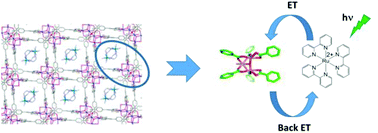当前位置:
X-MOL 学术
›
Dalton Trans.
›
论文详情
Our official English website, www.x-mol.net, welcomes your
feedback! (Note: you will need to create a separate account there.)
Guest to framework photoinduced electron transfer in a cobalt substituted RWLC-2 metal organic framework
Dalton Transactions ( IF 3.5 ) Pub Date : 2018-05-29 00:00:00 , DOI: 10.1039/c8dt01287c Christopher R. McKeithan 1, 2, 3, 4 , Lukasz Wojtas 1, 2, 3, 4 , Randy W. Larsen 1, 2, 3, 4
Dalton Transactions ( IF 3.5 ) Pub Date : 2018-05-29 00:00:00 , DOI: 10.1039/c8dt01287c Christopher R. McKeithan 1, 2, 3, 4 , Lukasz Wojtas 1, 2, 3, 4 , Randy W. Larsen 1, 2, 3, 4
Affiliation

|
Photoinduced electron transfer (PET) between donors and acceptors in porous materials is a key element in the development of light harvesting applications. Metal organic frameworks (MOFs) are ideal materials for PET processes due to their tunable pore size and diversity in framework building units. Here, PET between excited [Ru(2,2′-bipyridine)3]2+ (RuBpy) and Co-carboxylate clusters composing the metal building blocks of a RWLC-2 metal organic framework is described. The lifetime of the RuBpy decreases from ∼600 ns in deaerated solution to 9.5 ns (kET ∼ 1 × 108 s−1) when encapsulated within CoRWLC-2. The decrease in lifetime is attributed to PET between the 3MLCT of RuBpy to the Co ion cluster composing the MOF building blocks. A fit of the lifetime vs. temperature data to the semi-empirical Marcus equation gives a reorganizational energy of 1.6 eV and an electronic coupling factor (HAB) of 0.006 eV.
中文翻译:

来宾对钴取代的RWLC-2金属有机骨架中骨架的光致电子转移
多孔材料中供体和受体之间的光诱导电子转移(PET)是光收集应用开发中的关键要素。金属有机骨架(MOF)由于其可调的孔径和骨架构建单元的多样性而成为PET工艺的理想材料。在此,对构成RWLC-2金属有机骨架的金属结构单元的激发的[Ru(2,2'-联吡啶)3 ] 2+(RuBpy)与共羧酸酯簇之间的PET进行了说明。所述RuBpy的寿命从脱气溶液〜600纳秒降低到9.5毫微秒(ķ ET〜1×10 8小号-1时内CoRWLC-2封装的)。寿命的减少归因于PET介于3RuBpy的MLCT到组成MOF构建块的Co离子簇的过程。将寿命与温度数据拟合到半经验Marcus方程可得出1.6 eV的重组能和0.006 eV的电子耦合因子(H AB)。
更新日期:2018-05-29
中文翻译:

来宾对钴取代的RWLC-2金属有机骨架中骨架的光致电子转移
多孔材料中供体和受体之间的光诱导电子转移(PET)是光收集应用开发中的关键要素。金属有机骨架(MOF)由于其可调的孔径和骨架构建单元的多样性而成为PET工艺的理想材料。在此,对构成RWLC-2金属有机骨架的金属结构单元的激发的[Ru(2,2'-联吡啶)3 ] 2+(RuBpy)与共羧酸酯簇之间的PET进行了说明。所述RuBpy的寿命从脱气溶液〜600纳秒降低到9.5毫微秒(ķ ET〜1×10 8小号-1时内CoRWLC-2封装的)。寿命的减少归因于PET介于3RuBpy的MLCT到组成MOF构建块的Co离子簇的过程。将寿命与温度数据拟合到半经验Marcus方程可得出1.6 eV的重组能和0.006 eV的电子耦合因子(H AB)。











































 京公网安备 11010802027423号
京公网安备 11010802027423号